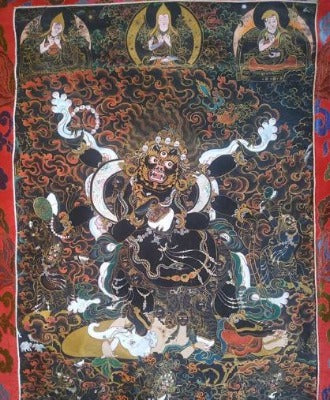Sed Gyued Monastery
6-Arm Mahakala Thangka
6-Arm Mahakala Thangka
Couldn't load pickup availability
Mahakala, the Great Black One, is such a wrathful deity. Mahakala embodies enlightened rage as well the divine protection that we need from our own minds. He is an emanation of the great Avalokiteshvara.
Mahakala has a rather ferocious appearance, given his status as the supreme Dharmapala. His eyes are burning with rage while his hair is upright and ablaze. He takes on an intimidating stance and the overall aura of the deity is quite formidable. But despite his terrifying appearance, he is a manifestation of the embodiment of universal compassion, Avalokiteshvara.
The common belief is that when the realization struck Avalokiteshvara that in this age of darkness, his peaceful ways would not be enough to subjugate the degenerate beings and protect them from going astray, he decided that a wrathful form would be more appropriate to accomplish his ever so compassionate goals. Hence, he emanated the dark blue syllable HUM and transformed into the divinely wrathful Mahakala. Avalokiteshvara’s resolve to take on this form for the benefit of others was praised by Amitabha and the ‘Ten Buddhas of the Ten Directions,’ who predicted that he would go on to serve as an invincible dharma protector in all realms. Fulfilling the prophecy, Mahakala appears in all the realms where enlightened beings appear and reveals the path to complete the spiritual awakening.
Mahakala, among his other manifestations, is more popular for his six-armed form. This form is black and blue, which is supposed to symbolize his changeless Dharmakaya nature. He has three eyes that represent the past, present and future and his clear comprehension of time. A crown of five skulls rests on his head, where the skulls represent the five poisonous delusions of anger, desire, ignorance, jealousy, and pride. These delusions are ultimately transformed into the wisdoms of the five Buddha families.
Mahakala is a protective deity, so he holds various ritual implements in his six hands to carry out his protective functions. The first right-hand holds a curved knife that cuts the ego attachment, and the left-hand holds a skull cup that shows his subjugation of evil-doers. This combination of the knife and the cup is the tantric union of method and wisdom as it represents the inseparability of bliss and emptiness.
The other right hands hold a rosary of skulls and a damaru that symbolize his continuous activity for the benefit of beings, and the control over all classes of Dakinis respectively. It is recognized that the damaru also makes the sound that arises us from our ignorance. The remaining left hands hold a trident and a lasso, where the trident symbolizes his power over the three spheres of existence, and the lasso with which he binds those who break their vows. The trident also represents the destruction of the three root delusions, and the lasso is that which reigns in the caprices of the confused mind.
The left leg is outstretched in Mahakala’s iconography, like that of some deities. The right leg is bent and it represents his accomplishments for the benefit of others and oneself. And much like other wrathful deities, he tramples on another deity, an elephant-headed one that symbolizes his destruction and dispersal of great obstacles. The elephant-headed quality of the trampled deity can represent wealth and otherworldly desires, and Mahakala’s domination over the deity shows the enlightened transformation of such a worldly trait.
Mahakala takes his stance upon a sun disc that symbolizes his illumination of the darkness of ignorance. This disc itself rests upon a lotus, which shows his undefiled purity. His powerful activities in consuming all the neurotic states of mind are demonstrated through the pores of his body. Clad in a tigerskin loincloth, a snake necklace adorns him as he holds an elephant skin. These three attributes represent Mahakala’s purification of desire, anger, and pride. Mahakala’s possession of the complete qualities of a fully enlightened Buddha can be seen in his other ornaments, by virtue of elaborate imagery.
“The Great Protector, Mahakala, the fierce god who is inseparable from my Lama [to whom] I present this thangka of the Great Protector, whose true spirit is ever present in the precious painting. . . . . May you the Great Protector always be near us and help us to follow the path to righteousness.”


